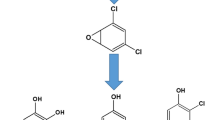Summary
Absorption and excretion of 1,1,1-trichloroethane, as well as the kinetics of formation and elimination of trichloroethanol (TCE) and trichloroacetic acid (TCA) were simulated by a mathematical model. The results of this model were compared with experimental ones on pulmonary elimination of the solvent and urinary excretion of the metabolites. The influences of duration and repetition of exposure on the pulmonary and urinary eliminations were studied. A tentative method of biologic monitoring is proposed. Theoretically, the most suitable method to estimate the exposure is by two determinations, before and after a work shift. Following this procedure, analysis of TCE in the urine is more sensitive than determination of 1,1,1-trichloroethane in the breath. As an indicator of exposure risk, TCA is not considered sensitive enough if variations in the inspired concentration occur.
Similar content being viewed by others
References
Åstrand I, Kilbom A, Wahlberg I, Ovrum P (1973) Methylchloroform exposure. I. Concentration in alveolar air and blood at rest and during exercise. Work Environ Health 10:69–81
Cowles AL, Borgsted HH, Gillies AJ (1971) Tissue weights and rates of blood flow in man for the prediction of anestheric uptake and distribution. Anesthesiology 35:523–526
Droz PO, Fernandez JG (1977a) Effect of physical workload on retention and metabolism of inhaled organic solvents. A comparative theoretical approach and its applications with regards to exposure monitoring. Int Arch Occup Environ Health 38:231–246
Droz PO, Fernandez JG (1977b) Solubility of organic solvents. I. Gas chromatographic determination of olive oil-gas partition on coefficients. Helv Chim Acta 60:454–458
Droz PO, Fernandez JG (1978a) Trichloroethylene exposure: Biological monitoring by breath and urine analysis. Br J Ind Med 35:35–42
Droz PO (1978b) Contribution à la recherche d'indices biologiques d'exposition aux solvants. Determination de leurs coefficients de partage et etude de leur comportement dans l'organisme à l'aide de modèles de simulation. Doctoral thesis, University of Neuchâtel, Switzerland
Fernandez JG, Droz PO, Humbert BE, Caperos JR (1977) Trichloroethylene exposure. Simulation of uptake, excretion, and metabolism using a mathematical model. Br J Ind Med 34:43–55
Humbert BE, Fernandez JG (1977) Exposition au 1,1,1-trichloroethane; contribution à l'étude de l'absorption, de l'excrémentation et du métabolisme sur des sujets humains. Arch Mal Prof 38:415–425
Monster AC, Boersma G, Steenweg H (1979a) Kinetics of 1,1,1-trichloroethane in volunteers; influence of exposure concentration and work load. Int Arch Occup Environ Health 42:293–301
Monster AC (1979b) Difference in uptake, elimination, and metabolism in exposure to trichloroethylene, 1,1,1-trichloroethane and tetrachloroethylene. Int Arch Occup Environ Health 42:311–317
Monster AC, Houtkooper JM (1979c) Estimation of individual uptake of trichloroethylene, 1,1,1-trichloroethane and tetrachloroethylene from biological parameters. Int Arch Occup Environ Health 42:319–323
Sato A, Nakajima T (1979) A structure-activity relationship of some chlorinated hydrocarbons. Arch Environ Health 34:69–75
Stewart RD, Gay HH, Erley DS, Hake CL, Schaffer AW (1961) Human exposure to 1,1,1trichloroethane vapor: relationship of expired air and blood concentration to exposure and toxicity. Am Ind Hyg Assoc J 22:252–262
Stewart RD, Gay HH, Schaffer AW, Erley DS, Rowe VK (1969) Experimental human exposure to methylchloroform vapor. Arch Environ Health 19:467–472
Stewart RD, Hake CL, Wu A, Graff SA, Forster HV, Lebrun AJ, Newton PE, Soto RJ (1975) Report no.: NIOSH-MCOW-ENVM-1,1,1-t-75-4, June
Tables scientifiques (1963) 6th edn. Documenta. Geigy, Basel, pp 642–643
Author information
Authors and Affiliations
Rights and permissions
About this article
Cite this article
Caperos, J.R., Droz, P.O., Hake, C.L. et al. 1,1,1-Trichloroethane exposure, biologic monitoring by breath and urine analyses. Int. Arch Occup Environ Heath 49, 293–303 (1982). https://doi.org/10.1007/BF00377938
Received:
Accepted:
Issue Date:
DOI: https://doi.org/10.1007/BF00377938




